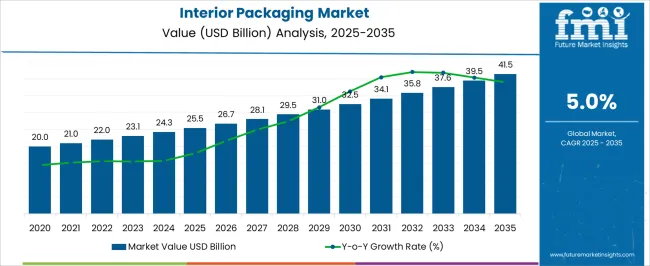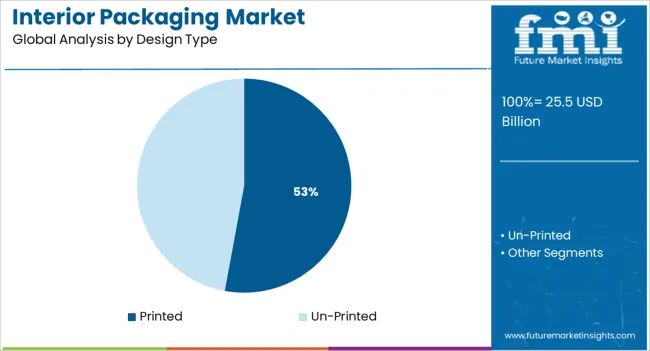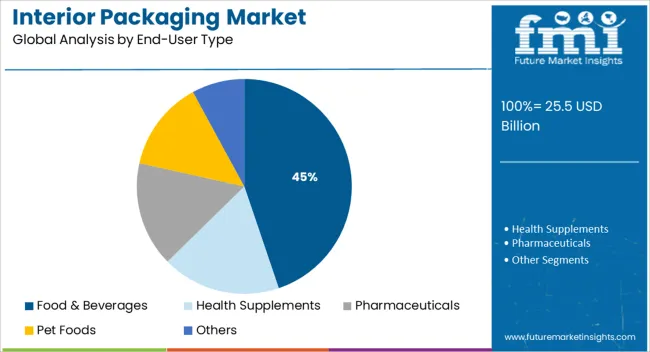The Interior Packaging Market is estimated to be valued at USD 25.5 billion in 2025 and is projected to reach USD 41.5 billion by 2035, registering a compound annual growth rate (CAGR) of 5.0% over the forecast period.

| Metric | Value |
|---|---|
| Interior Packaging Market Estimated Value in (2025E) | USD 25.5 billion |
| Interior Packaging Market Forecast Value in (2035F) | USD 41.5 billion |
| Forecast CAGR (2025 to 2035) | 5.0% |
The interior packaging market is experiencing accelerated transformation, shaped by increasing pressure on brands to optimize product protection while maintaining sustainability, branding, and logistics efficiency. As global trade intensifies and eCommerce expands, the need for protective packaging solutions that ensure structural integrity during transportation and handling has become more critical. Interior packaging is evolving into a functional brand asset, enabled by innovations in design, recyclable materials, and smart packaging technologies.
Companies are investing in automation-compatible, lightweight, and cost-effective materials to reduce wastage, lower carbon footprints, and improve operational throughput. Regulatory pushes toward eco-friendly packaging mandates and heightened consumer awareness around environmental impact have led to a shift toward materials that are both protective and sustainable.
Future growth will be supported by increasing demand from the food and beverage industry, electronics, pharmaceuticals, and retail sectors where product presentation, shelf life, and transit protection play a decisive role As global markets demand both functional and aesthetic packaging, interior packaging is expected to emerge as a strategic differentiator.
The market is segmented by Material Type, Design Type, and End-User Type and region. By Material Type, the market is divided into Plastic, Aluminum Foil, Coated Papers, and Others. In terms of Design Type, the market is classified into Printed and Un-Printed. Based on End-User Type, the market is segmented into Food & Beverages, Health Supplements, Pharmaceuticals, Pet Foods, and Others. Regionally, the market is classified into North America, Latin America, Western Europe, Eastern Europe, Balkan & Baltic Countries, Russia & Belarus, Central Asia, East Asia, South Asia & Pacific, and the Middle East & Africa.

Plastic is expected to account for 47.5% of the total revenue share in the interior packaging market in 2025, reflecting its dominant role as the material of choice for manufacturers. This growth has been influenced by plastic's versatility, lightweight nature, and superior barrier properties which make it suitable for moisture-sensitive, fragile, or perishable products. Plastic-based interior packaging solutions have become widely adopted due to their adaptability to various product shapes and ease of incorporation into automated packing lines.
High durability and resistance to impact during transport have also contributed to the segment’s leadership. Furthermore, advancements in recyclable plastics and biodegradable polymers have allowed companies to align with environmental regulations without compromising product protection.
The cost-effectiveness and scalability of plastic materials in bulk packaging applications continue to support their widespread use As industries prioritize efficient packaging that balances sustainability with performance, the demand for innovative plastic-based interior packaging formats is anticipated to remain strong.

Printed designs are projected to represent 52.9% of the overall revenue share in the interior packaging market in 2025, positioning them as the leading design type. This leadership is being supported by the growing need for branded experiences, especially in food and consumer goods sectors where visual appeal and information clarity directly influence purchasing decisions. Printed interior packaging has enabled companies to deliver messaging, product instructions, QR codes, and sustainability labels directly within the packaging environment, enhancing user engagement.
Developments in digital and flexographic printing technologies have made it feasible to produce high-resolution, short-run, and personalized designs efficiently. Additionally, regulatory compliance requiring traceability and safety information has contributed to the increased adoption of printed designs.
The segment has also benefited from the rise of eCommerce, where unboxing experiences play a crucial marketing role As brand visibility and consumer interaction become central to packaging strategies, printed designs are expected to retain their competitive edge in the market.

The food and beverages sector is projected to hold 44.8% of the interior packaging market share in 2025, highlighting its position as the most prominent end-use category. This dominance is being driven by the increasing need for secure, hygienic, and visually appealing packaging solutions that maintain product quality throughout the distribution cycle. Interior packaging plays a critical role in minimizing spoilage, preventing cross-contamination, and extending shelf life, especially in perishable and ready-to-consume product lines.
The growth of global food trade, expanding cold chain infrastructure, and rising consumer expectations for freshness have led to the widespread integration of smart and functional interior packaging solutions. The sector has also witnessed heightened demand for sustainable and food-safe materials that comply with evolving health and safety regulations.
Furthermore, innovations in compartmentalized packaging, tamper-evident designs, and portion control formats have made interior packaging a vital component in foodservice, retail, and on-the-go consumption models As consumer-centric packaging becomes a standard in the food and beverages industry, this segment is expected to drive consistent market growth.
Interior Packaging is the packaging layer applied directly over the product. The Interior packaging is the first layer of packaging in which the product is contained. For product manufacturer its utmost important to pack the commodities or goods with best possible way so that the later is least damaged or spoilt during handling or transportation.
Packaging industries has undergone tremendous evolution in last few decades due to which it there has been many innovations and changes. Interior packaging has been one such development from packaging industries on which now company depends for improved packaging of their products for product longevity and quality.
With growth in various industries such as F&B, FMCG etc. it can be anticipated that interior packaging will be growth exponentially over the forecast period.
The factors fueling the market growth of the Interior packaging market are ease to storing, measuring, handling and transporting the goods and commodities in various forms such as liquid, powder or semi liquid state. With ease of doing business now companies and industries to expand globally for which it needs to transport their goods and products to various places within nation boundaries as well as international boundaries.
In order to keep products and goods in appropriate conditions such interior packaging has been gaining greater importance across various industries. Interior packaging also helps the manufacturers to maintain the aesthetic look of the product.
Across various regions industries such as which manufactures various foods and commodities are on expansion spree to meet the high demand of consumers which will again also boost the growth of interior packaging.
Even other industries such as alternative medicines, supplement industries as well as pharmaceutical products are gaining affinity which will again be an another factor that will drive the growth of interior packaging. Growth in modern retail format, e-commerce industry again are few of the various other products which will indirectly infuse momentum in interior packaging market.
However, in developing nations due to absence of demand of certain goods and commodities, can present challenge to the growth of interior packaging. But nevertheless companies and manufacturers are on competition to give best quality product in optimum packaging standard which will eventually mitigate any possibilities that can be any sort of restraint for the growth of interior packaging.
Geographically, the global vial Interior packaging market is segmented into North America, Latin America, Western Europe, Eastern Europe, Japan, Middle East and Africa and Asia-Pacific excluding Japan.
The North America market dominate the global Interior packaging market regarding market share owing to increase in the adoption of such packaging for packaging of various commodities and products. Next to North America, Asia Pacific has been gaining tremendous growth in interior packaging.
APEJ is a region with countries with huge population and thus demand of various goods and commodities which is fuelling the demand of interior packaging. Western Europe is also a prominent region where interior packaging has a substantial demand. Japan on the other hand due to its advance process of packaging goods and commodities is pushing the growth of interior packaging.
MEA & Latin America has also witnessed growth in establishments of various industries such as F&B industries, FMCG industries etc. which will be the major consumer of interior packaging subsequently. Overall the interior packaging is gaining significant acceptance across various region and countries.
Some of the prominent players of the global Interior packaging market include-
The research report presents a comprehensive assessment of the market and contains thoughtful insights, facts, historical data, and statistically supported and industry-validated market data.
It also contains projections using a suitable set of assumptions and methodologies. The research report provides analysis and information according to categories such as market segments, geographies, type of product and applications.
The global interior packaging market is estimated to be valued at USD 25.5 billion in 2025.
The market size for the interior packaging market is projected to reach USD 41.5 billion by 2035.
The interior packaging market is expected to grow at a 5.0% CAGR between 2025 and 2035.
The key product types in interior packaging market are plastic, aluminum foil, coated papers and others.
In terms of design type, printed segment to command 52.9% share in the interior packaging market in 2025.






Full Research Suite comprises of:
Market outlook & trends analysis
Interviews & case studies
Strategic recommendations
Vendor profiles & capabilities analysis
5-year forecasts
8 regions and 60+ country-level data splits
Market segment data splits
12 months of continuous data updates
DELIVERED AS:
PDF EXCEL ONLINE
Competitive Breakdown of Interior Packaging Manufacturers
Wooden Interior Door Market Size and Share Forecast Outlook 2025 to 2035
Luxury Interior Fabric Industry Analysis in North America and Europe Growth, Trends and Forecast from 2025 to 2035
Vehicle Interior Air Quality Monitoring Technology Market Analysis - Size, Share, and Forecast Outlook 2025 to 2035
Railway Interior Lighting Market - Trends & Forecast 2025 to 2035
Aircraft Interior Lighting Market Size and Share Forecast Outlook 2025 to 2035
Aerospace Interior Market Size and Share Forecast Outlook 2025 to 2035
Automotive Interior Market Forecast Outlook 2025 to 2035
Automotive Interior Plastic Components Market Size and Share Forecast Outlook 2025 to 2035
Automotive Interior Leather Market Analysis Size Share and Forecast Outlook 2025 to 2035
Automotive Interior Trim Parts Market Size and Share Forecast Outlook 2025 to 2035
Automotive Interior Ambient Lighting Market Growth - Trends & Forecast 2025 to 2035
Residential Interior Wood Doors Market Size and Share Forecast Outlook 2025 to 2035
Aircraft Cabin Interior Market Size and Share Forecast Outlook 2025 to 2035
Aircraft Cabin Interior Market Analysis - Size, Share, and Forecast Outlook 2025 to 2035
Aircraft Cabin Interiors Market Size and Share Forecast Outlook 2025 to 2035
Bioplastic For Interior Market Size and Share Forecast Outlook 2025 to 2035
Japan Automotive Interior Leather Market Growth – Trends & Forecast 2023-2033
Korea Automotive Interior Leather Market Growth – Trends & Forecast 2023-2033
Automotive Plastic Interior Trims Market Growth - Trends & Forecast 2025 to 2035

Thank you!
You will receive an email from our Business Development Manager. Please be sure to check your SPAM/JUNK folder too.
Chat With
MaRIA